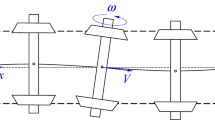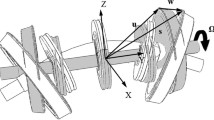Abstract
To study the vehicle hunting behavior and its coupling with car body vibrations, a simplified lateral-dynamics-intended railway vehicle model is developed. A two-truck vehicle is modeled as a 17 degrees-of-freedom rigid system, into which the car body flexural vibrations of torsion and bending modes are further integrated. The wheel/rail interaction employs a real-time calculation for the Hertzian normal contact, in which the nonlinear curvatures of wheel and rail profiles are presented as functions of wheelset lateral movement and/or yaw rotation. Then the tangential/creep forces are analytically expressed as the Hertzian contact patch geometry, and lead to a continuous and fast calculation compared to a look-up table interpolation. It is shown that the hunting frequencies of the vehicle model and a truck model differ significantly, which verifies the necessity of the whole vehicle model. In the case of low wheel/rail conicity, the hunting frequency increases linearly with vehicle speed, whereas it rises slowly at high speed for a large conicity. Comparison of hunting frequency and damping ratio between various conicities shows that first hunting (car body hunting) may occur when the vehicle is operated at a low speed in a small conicity case, while a second hunting (truck hunting) appears when the vehicle is operated at a high speed in a large conicity case. Stability analysis of linear and nonlinear vehicle models was carried out through coast down method and constant speed simulations. Results tell that the linear one overestimates the lateral vibrating. Whereas the structural vibrations of car body can be ignored in the stability analysis. Compared to existing simplified models for hunting stability study, the proposed simplified vehicle model released limitations in the nonlinear geometries of wheel/rail profiles, and it is suitable for a frequency-domain analysis by deriving the analytical expressions of the normal and tangential wheel/rail contact forces.
Graphic abstract










Similar content being viewed by others
References
Shi, H., Wu, P.: Flexible vibration analysis for car body of high-speed EMU. J. Mech. Sci. Technol. 30, 55–66 (2016). https://doi.org/10.1007/s12206-015-1207-6
Wei, L., Zeng, J., Chi, M., et al.: Carbody elastic vibrations of high-speed vehicles caused by truck hunting instability. Veh. Syst. Dyn. 55, 1321–1342 (2017). https://doi.org/10.1080/00423114.2017.1310386
Shi, H., Wang, J., Wu, P., et al.: Field measurements of the evolution of wheel wear and vehicle dynamics for high-speed trains. Veh. Syst. Dyn. 56, 1187–1206 (2018). https://doi.org/10.1080/00423114.2017.1406963
Luo, R., Shi, H.: Dynamics of Railway Vehicle Systems and Application. Southwest Jiaotong University Press, Chengdu (2018). (in Chinese)
Yan, Y., Zeng, J., Huang, C., et al.: Bifurcation analysis of railway truck with yaw damper. Arch. Appl. Mech. 89, 1185–1199 (2019). https://doi.org/10.1007/s00419-018-1475-6
Knothe, K., Stichel, S.: Rail Vehicle Dynamics. Springer Nature, Switzerland (2016)
Polach, O.: Characteristic parameters of nonlinear wheel/rail contact geometry. Veh. Syst. Dyn. 48, 19–36 (2010). https://doi.org/10.1080/00423111003668203
Shi, H., Luo, R., Wu, P., et al.: Application of DVA theory in vibration reduction of carbody with suspended equipment for high-speed EMU. Sci. China Technol. Sci. 57, 1425–1438 (2014). https://doi.org/10.1007/s11431-014-5558-5
Antunes, P., Magalhães, H., Ambrosio, J., et al.: A co-simulation approach to the wheel–rail contact with flexible railway track. Multibody Syst. Dyn. 45, 245–272 (2019). https://doi.org/10.1007/s11044-018-09646-0
Zhai, W., Xia, H., Cai, C., et al.: High-speed train-track-bridge dynamic interactions - part I: theoretical model and numerical simulation. Int. J. Rail Trans. 1, 3–24 (2013). https://doi.org/10.1080/23248378.2013.791498
Ling, L., Zhang, Q., Xiao, X., et al.: Integration of car-body flexibility into train-track coupling system dynamics analysis. Veh. Syst. Dyn. 56, 485–505 (2018). https://doi.org/10.1080/00423114.2017.1391397
Zhao, Y., Si, L.T., Ouyang, H.: Combined approach for analysing evolutionary power spectra of a track-soil system under moving random loads. Acta Mech. Sin. 35, 674–690 (2019). https://doi.org/10.1007/s10409-019-00842-5
Dumitriu, M.: A new passive approach to reducing the carbody vertical bending vibration of railway vehicles. Veh. Syst. Dyn. 55, 1787–1806 (2017). https://doi.org/10.1080/00423114.2017.1330962
Zheng, X., Zolotas, A.C., Goodall, R.M., et al.: Combined active suspension and structural damping control for suppression of flexible bodied railway vehicle vibration. Veh. Syst. Dyn. 58, 198–228 (2020). https://doi.org/10.1080/00423114.2019.1572902
Huang, C., Zeng, J., Luo, G., et al.: Numerical and experimental studies on the car body flexible vibration reduction due to the effect of car body-mounted equipment. Proc. IMechE Part F 232, 103–120 (2018). https://doi.org/10.1177/0954409716657372
Gong, D., Zhou, J., Sun, W.: Passive control of railway vehicle car body flexural vibration by means of underframe dampers. J. Mech. Sci. Technol. 31, 555–564 (2017). https://doi.org/10.1007/s12206-017-0108-2
Wen, Y., Sun, Q., Zou, Y., et al.: Study on the vibration suppression of a flexible carbody for urban railway vehicles with a magnetorheological elastomer-based dynamic vibration absorber. Proc. IMechE Part F 234, 749–764 (2020). https://doi.org/10.1177/0954409719865370
Tomioka, T., Takigami, T.: Reduction of bending vibration in railway vehicle carbodies using carbody-bogie dynamic interaction. Veh. Syst. Dyn. 48, 467–486 (2010). https://doi.org/10.1080/00423114.2010.490589
Guo, J., Shi, H., Luo, R., et al.: Parametric analysis of the car-body suspended equipment for railway vehicles vibration reduction. IEEE Access 7, 88116–88125 (2019). https://doi.org/10.1109/ACCESS.2019.2918777
Schandl, G., Lugner, P., Benatzky, C., et al.: Comfort enhancement by an active vibration reduction system for a flexible railway car body. Veh. Syst. Dyn. 45, 835–847 (2007). https://doi.org/10.1080/00423110601145952
Bokaeian, V., Rezvani, M.A., Arcos, R.: The coupled effects of bending and torsional flexural modes of a high-speed train car body on its vertical ride quality. Proc. IMechE Part K 233, 979–993 (2019). https://doi.org/10.1177/1464419319856191
Lee, S.Y., Cheng, Y.C.: Hunting stability analysis of high-speed railway vehicle trucks on tangent tracks. J. Sound Vib. 282, 881–898 (2005). https://doi.org/10.1016/j.jsv.2004.03.050
Cheng, Y.C., Lee, S.Y., Chen, H.H.: Modeling and nonlinear hunting stability analysis of high-speed railway vehicle moving on curved tracks. J. Sound Vib. 324, 139–160 (2009). https://doi.org/10.1016/j.jsv.2009.01.053
Wu, X., Chi, M.: Parameters study of Hopf bifurcation in railway vehicle system. J. Comput. Nonlinear Dyn. 10, 031012 (2015). https://doi.org/10.1115/1.4027683
Zhang, T., Dai, H.: Loss of stability of a railway wheel-set, subcritical or supercritical. Veh. Syst. Dyn. 55, 1731–1747 (2017). https://doi.org/10.1080/00423114.2017.1319963
von Wagner, U.: Nonlinear dynamic behaviour of a railway wheelset. Veh. Syst. Dyn. 47, 627–640 (2009). https://doi.org/10.1080/00423110802331575
Ahmadian, M., Yang, S.: Effect of system nonlinearities on locomotive truck hunting stability. Veh. Syst. Dyn. 29, 365–384 (1998). https://doi.org/10.1080/00423119808969380
Zeng, J., Wu, P.: Stability analysis of high speed railway vehicles. JSME Int J. Ser. C 47, 464–470 (2004). https://doi.org/10.1299/jsmec.47.464
Fu, B., Giossi, R.L., Persson, R., et al.: Active suspension in railway vehicles: a literature survey. Railway Eng. Sci. 28, 3–35 (2020). https://doi.org/10.1007/s40534-020-00207-w
Shabana, A.A., Zaazaa, K.E., Sugiyama, H.: Railroad Vehicle Dynamics: A Computational Approach. CRC Press, Boca Raton (FL) (2008)
Pombo, J., Ambrósio, J., Silva, M.: A new wheel–rail contact model for railway dynamics. Veh. Syst. Dyn. 45, 165–189 (2007). https://doi.org/10.1080/00423110600996017
Pappalardo, C.M., Desimone, M.C., Guida, D.: Multibody modeling and nonlinear control of the pantograph/catenary system. Arch. Appl. Mech. 89, 1589–1626 (2019). https://doi.org/10.1007/s00419-019-01530-3
Sun, J., Chi, M., Cai, W., et al.: Numerical investigation into the critical speed and frequency of the hunting motion in railway vehicle system. Math. Probl. Eng. (2019). https://doi.org/10.1155/2019/7163732
Iwnicki, S., Spiryagin, M., Cole, C., et al.: Handbook of Railway Vehicle Dynamics, 2nd edn. CRC Press, Boca Raton (2019)
Ling, L., Jiang, P., Wang, K., et al.: Nonlinear stability of rail vehicles traveling on vibration-attenuating slab tracks. J. Comput. Nonlinear Dyn. 15, 071005 (2020). https://doi.org/10.1115/1.4047087
Shen, Z., Hedrick, J.K., Elkins, J.A.: A comparison of alternative creep force models for rail vehicle dynamic analysis. Veh. Syst. Dyn. 12, 79–83 (1983). https://doi.org/10.1080/00423118308968725
Escalona, J.L., Aceituno, J.F.: Multibody simulation of railway vehicles with contact lookup tables. Int. J. Mech. Sci. 155, 571–582 (2019). https://doi.org/10.1016/j.ijmecsci.2018.01.020
Huang, C., Zeng, J., Liang, S.: Influence of system parameters on the stability limit of the undisturbed motion of a motor bogie. Proc. IMechE Part F 228, 522–534 (2014). https://doi.org/10.1177/0954409713488099
Yao, Y., Li, G., Sardahi, Y., et al.: Stability enhancement of a high-speed train bogie using active mass inertial actuators. Veh. Syst. Dyn. 57, 389–407 (2019). https://doi.org/10.1080/00423114.2018.146977
Acknowledgments
The project was supported by the National Natural Science Foundation of China (Grants 51805451, U1934202, and U2034210), the Sichuan Science and Technology Plan Project (Grant 2020YJ0074), the Fundamental Research Funds for the Central Universities (Grant 2682019CX43), and the TPL Independent R&D Project (Grants 2018TPL_T08 and 2019TPL_T15).
Author information
Authors and Affiliations
Corresponding author
Additional information
Executive Editor: Qiang Tian
Rights and permissions
About this article
Cite this article
Shi, H., Luo, R. & Guo, J. Improved lateral-dynamics-intended railway vehicle model involving nonlinear wheel/rail interaction and car body flexibility. Acta Mech. Sin. 37, 997–1012 (2021). https://doi.org/10.1007/s10409-021-01059-1
Received:
Revised:
Accepted:
Published:
Issue Date:
DOI: https://doi.org/10.1007/s10409-021-01059-1




